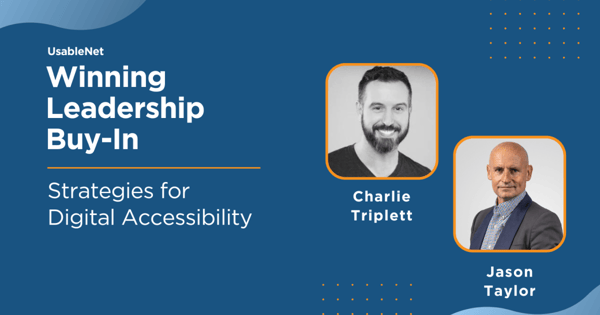For a company to prioritize digital accessibility, creating a corporate culture around it is essential. For too many organizations, accessibility is an afterthought.
There are many challenges involved in shifting your company’s culture, but it’s possible--and it can be done well. Let’s talk about the changes and mindset shifts involved in making a positive transformation toward greater accessibility.
Why There’s a History of Exclusion with Web Accessibility
Unfortunately, there’s a history of exclusion regarding web accessibility. This happens primarily due to a lack of understanding among those who design and create websites, programs, software, and applications for the web. The abled individuals engaged in this work don’t understand:
- How many end-users are people who live with disabilities
- How this lack of accessibility impacts disabled individuals who use the web
- That they should be making accessibility a centerpiece of their digital product or service creation
- How to create an accessibility program they can sustain long-term
- The full process involved in designing, creating content, coding, and testing for accessibility to ensure disabled individuals can access these digital properties
- How digital accessibility, or the lack thereof, can either positively or negatively impact a brand
Rather than being treated as a critical component of a digital product’s overall functionality, accessibility is regarded as a “nice to have” feature in many cases and pushed off as a future task.
How to Implement Web Accessibility Into Company Processes
One way to change the landscape of web accessibility is to implement it within company processes directly. Each team involved in creating web properties must learn how to create websites, apps, and content that is accessible to everyone.
Because accessibility arrives on the scene as an additional requirement that teams across a company need to manage, it can be difficult for companies to embrace. As a result, it often begins as a project that requires the team to adapt its processes.
To bake accessibility into permanent company processes, it must be sustainable for a long time. And that means starting with accessibility as a core consideration.
Transforming the Company's DNA
Making accessibility sustainable will mean transforming the brand's DNA from the inside out. Several essential steps must be taken to make these changes. Let’s take a look at what those are.
1. Encourage Team Members to Become Champions for Accessibility
To make genuine, lasting changes to your company’s processes, you’ll need designated accessibility champions to rise to the challenge. You can find and create these champions through intentional conversations surrounding the importance of accessibility.
Ideally, everyone on your team will become champions simply by paying attention to these important conversations. However, you’ll want to focus on cultivating champions from the following departments:
- C-suite and executive branches
- Human resources
- Stakeholders in products and marketing
- Diversity, Equity, and Inclusion (DEI) leaders
- IT and tech leaders
- Inter-departmental teams working on projects daily
You can inspire your champions to action; ideally, they will begin to inspire one another.
2. Move in the Direction of an Accessibility-First Outlook
Your organization will need to begin embracing a mindset of accessibility first. Here are a few ways to begin that process.
- We recommend creating an Accessibility Policy for your company that outlines your organization’s goals for web accessibility.
- If your company is already focused on DEI, make accessibility a part of that initiative’s mission. It fits naturally into every organization's significant efforts to ensure all disabled individuals are included, customers and employees alike.
- Educate your employees on accessibility and why the organization must embrace and implement it.
3. Make Sure Your Goals are Both Achievable and Sustainable
Adopting a digital accessibility culture in your company will take time, so breaking it down into achievable, sustainable goals is incredibly important. You’ll need to work with your interdepartmental teams to develop realistic timelines for the changes and remediations.
Drafting and adopting your Accessibility Policy will take time and multiple revisions.
As you determine the timeline to include accessibility in your software development cycle, set up milestones to help you track progress. Additionally, you’ll need to account for the time and resources it will take to implement ongoing education throughout the company.
4. Be Aware of Potential Challenges and Setbacks Ahead
Along the road to transformation, be aware of potential challenges and setbacks as you adopt digital accessibility. For example, track teams or projects where accessibility is deprioritized for any reason.
In addition, you may encounter partners and vendors who aren’t enthusiastic about accessibility. If they don’t have the awareness, knowledge, or capacity to do the work, then you may need to look for new vendors who do.
Lacking a central process for accessibility can also make these changes more challenging. Siloed teams are at higher risk of sidelining the changes. This is equally true if individuals inside your organization are resistant.
Building better habits across your company is essential as you make these changes. Atomic Habits by James Clear is a fantastic resource for helping leaders to build stronger, more effective habits.
5. Educate Your Team at Every Opportunity
Education is critical to inspiring accessibility champions to help lead change within your organization. Be sure that you share:
- Statistics that help deepen understanding of the disabled community
- Information on types of disabilities that impact a person’s ability to access digital properties
- Examples of accessibility issues in digital media, such as social media or emails
- Information on what changes you can make within your company, starting now
- Any additional resources that could be helpful in inspiring change
Related Blog: Building Your Arsenal: Empowering Conversations for Web Accessibility
6. Raise Awareness Among Project Teams
Your teams will need to ask themselves a series of important questions to become more aware of each project’s accessibility needs. They can ask things like:
- Are we aware of how accessible our website or app is?
- What would it take to audit our digital properties so we can make changes?
- In what order should those digital properties be prioritized as we implement accessibility?
- What can we do to get the process started?
- What other team members or departments need to be involved?
- How can we better include our users in the future?
- What can our team do to be more proactive in accessibility efforts?
- How do we prevent unnecessary issues in future audits and/or user tests?
- How and when can we begin incorporating disabled end users into our testing processes?
- Where can we address accessibility issues earlier in the development process so they don’t catch us by surprise at the end of a project?
What Next?
Now that you understand the importance of creating a culture of digital accessibility in your company, it’s time to start. First, you’ll need to get a clear understanding of where you’re currently at when it comes to accessibility.
Next, identify the individuals, teams, and leaders to talk to and start meaningful conversations about accessibility and how your company should approach it. Along the way, you’ll begin to find your champions.
Finally, begin planning how to spread the word and implement change. Set goals and timelines for these changes, and be accountable to them.







